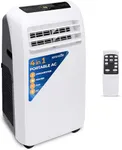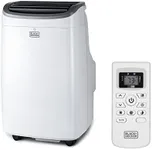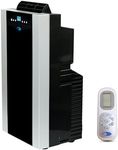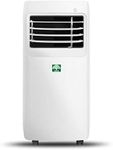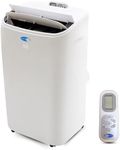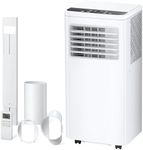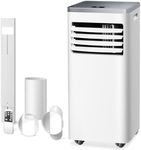Buying Guide for the Best Portable Ac Heat Pumps
Choosing a portable AC heat pump can make your living space comfortable year-round, offering both cooling in the summer and heating in the winter. The key to finding the right one is understanding your room size, climate needs, and how you plan to use the unit. By focusing on the main specifications, you can match a model to your lifestyle and ensure efficient, effective temperature control.BTU (British Thermal Units)BTU measures the cooling or heating power of the unit. A higher BTU means the device can handle larger spaces, while a lower BTU is suitable for smaller rooms. Typically, small rooms (up to 200 sq ft) need around 8,000 BTU, medium rooms (200-400 sq ft) need 10,000-12,000 BTU, and large rooms (over 400 sq ft) may require 14,000 BTU or more. To pick the right BTU, consider the size of the room you want to heat or cool. Choosing a unit with too low BTU will make it struggle, while too high can waste energy and not dehumidify properly.
Energy Efficiency Ratio (EER)EER tells you how efficiently the unit uses electricity to cool or heat. A higher EER means better efficiency, which can save you money on energy bills and is better for the environment. EER values usually range from about 8 to 12. If you plan to use the unit often or for long periods, look for a higher EER. For occasional use, a lower EER may be acceptable.
Heating and Cooling ModesPortable AC heat pumps can offer just cooling, just heating, or both. Some units have additional modes like dehumidifying or fan-only. If you need year-round comfort, make sure the unit can both heat and cool. If you only need one function, you can focus on that mode. Think about your climate and whether you need both heating and cooling to guide your choice.
Noise LevelNoise level is measured in decibels (dB) and tells you how loud the unit will be when running. Lower dB values mean quieter operation. Units can range from about 45 dB (quiet) to over 60 dB (louder). If you plan to use the unit in a bedroom or office, look for a quieter model. For living rooms or areas where noise is less of a concern, a higher noise level may be acceptable.
Portability and SizePortability refers to how easy it is to move the unit from room to room. This depends on the weight, size, and whether it has wheels or handles. Smaller, lighter units are easier to move but may have less power. Larger units can handle bigger spaces but are harder to relocate. Consider where you plan to use the unit and if you need to move it often to decide on the right size and portability.
Exhaust and Drainage SystemPortable AC heat pumps need to vent hot air outside, usually through a window kit, and may also need to drain water collected from the air. Some units have self-evaporating systems that reduce the need to empty water, while others require manual draining. If you want less maintenance, look for a self-evaporating or easy-drain system. If you don’t mind occasional emptying, a manual drain may be fine.
Control FeaturesControl features include things like remote controls, programmable timers, digital displays, and smart connectivity (like Wi-Fi or app control). More advanced controls can make the unit easier and more convenient to use, especially if you want to set schedules or adjust settings from a distance. If you value convenience, look for units with more control options. If you prefer simplicity, basic controls may be enough.
